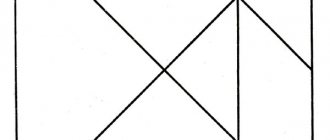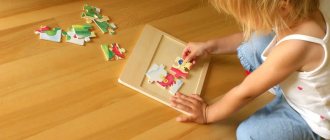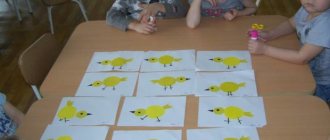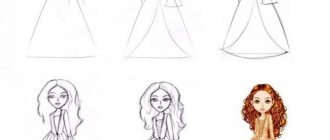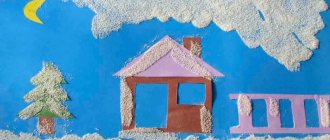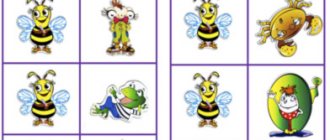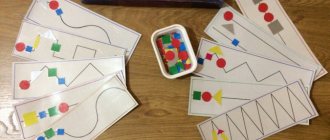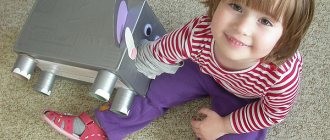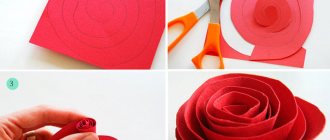Tangram is an ancient oriental puzzle made from figures obtained by cutting a square into 7 parts in a special way: 2 large triangles, one medium one, 2 small triangles, a square and a parallelogram. As a result of folding these parts together, flat figures are obtained, the contours of which resemble all kinds of objects, from humans, animals to tools and household items. These types of puzzles are often called "geometric puzzles", "cardboard puzzles" or "cut puzzles".
With a tangram, a child will learn to analyze images, identify geometric shapes in them, learn to visually break an entire object into parts, and vice versa - to compose a given model from elements, and most importantly - to think logically.
How to make a tangram
A tangram can be made from cardboard or paper by printing a template and cutting along the lines. You can download and print the tangram square diagram by clicking on the picture and selecting “print” or “save image as...”.
It is possible without a template. We draw a diagonal in the square - we get 2 triangles. We cut one of them in half into 2 small triangles. Mark the middle on each side of the second large triangle. We cut off the middle triangle and other shapes using these marks. There are other options for how to draw a tangram, but when you cut it into pieces, they will be absolutely the same.
A more practical and durable tangram can be cut from a rigid office folder or a plastic DVD box. You can complicate your task a little by cutting out a tangram from pieces of different felt, stitching them along the edges, or even from plywood or wood.
Tangram material: wooden, magnetic, cardboard, plastic
Tangram can be made of different materials. The simplest option that can be easily made at home is a cardboard tangram. But, as you understand, it is also the most fragile.
An excellent solution would be to purchase or make a wooden tangram at home. Long-lasting, durable and eco-friendly, it's sure to be passed down from today's kids to their own.
It is very convenient to play with a magnetic tangram: you can create figures on a special field, where they will not move anywhere or overlap each other. It is quite easy to make it at home from special foam and magnets or a special magnetic tape (soft magnet).
Plastic tangrams are quite strong and durable. You can also make them yourself.
How to play tangram
Each piece of the game must be made up of seven tangram parts, and they must not overlap.
The easiest option for preschool children 4-5 years old is to assemble figures according to the diagrams (answers) laid out into elements, like a mosaic. A little practice, and the child will learn to make figures according to the pattern-contour and even come up with his own figures according to the same principle.
Level one - download and print the colored tangram, this will make it easier to navigate the diagram.
Rules of the game
1. Each assembled figure must include all seven elements.
2. When composing figures, elements should not overlap each other. 3. The elements of the figures must be adjacent to one another. Creating a tangram
Puzzle games are popular with both children and adults: they are exciting, develop intelligence and innovative thinking, raise self-esteem, and do not require special knowledge. In addition, such games are an excellent replacement for the electronic gadgets that have captured the time and minds of modern people. Perhaps one of the most famous puzzles is the tangram - a square cut into seven parts. In today's article we will look at the main aspects associated with this exciting game: the history of the tangram, the rules of the game, the benefits for child development and ways to make a tangram yourself.
Schemes and figures of the tangram game
Recently, tangrams have been often used by designers. The most successful use of tangram is perhaps as furniture. There are tangram tables, transformable upholstered furniture, and cabinet furniture. All furniture built on the tangram principle is quite comfortable and functional. It can change depending on the mood and desire of the owner. How many different options and combinations can be made from triangular, square and quadrangular shelves. When purchasing such furniture, along with instructions, the buyer is given several sheets with pictures on different topics that can be folded from these shelves. In the living room you can hang shelves in the shape of people, in the nursery you can put cats, hares and birds from the same shelves, and in the dining room or library - the drawing can be on a construction theme - houses, castles, temples.
Here is such a multifunctional tangram.
On magnets, which I made a couple of days ago, that Ostap carried me further! Well, so what - the magnet is idle! Now I know how long a roll of 100*100 cm is enough - for 5 magnetic musical instruments, the size of an album sheet, and also for a huge Pentamino, a huge Tangram, and no less huge Pythagoras, Leaf, Mongolian and Vietnamese game, Kolubovo egg and letter T.
And after that, a piece slightly larger than A4 size still remained. I would have also made a Stomachion and a Magic Circle, but suddenly it turned out that this magnet does not magnetize to surfaces on the reverse side. This is a minus, of course. Due to this, asymmetrical puzzle pieces are difficult to use, because all of them can be turned over according to the rules. Assembling as many as you like on the table, but like magnets, it’s already difficult. By the way, the same Pentamino will have to be supplemented with duplicates of asymmetrical figures in mirror image, there are exactly half of them from the set.
But thanks to this property of the magnet, I learned that Sanya can very well collect figures in mirror image, without any problems. He assembled a duck from the “Leaf” puzzle according to the diagram. And there you need to use an asymmetrical quadrilateral, and in our case it is turned in the wrong direction as in the diagram. I suggested that Sanya assemble the piece in the opposite direction, and he immediately took it and rearranged everything in a mirror, without even thinking. I wouldn’t have thought of such a move myself, but it turned out good and useful. True, the parallelogram also turned out to be in the wrong direction, but we took it from another puzzle, so it is of a different color. It turned out like this:
The duck in the diagram is the original version, but with the blue neck he assembled it himself. In general, he assembled all the figures that I photographed himself, and very quickly, without “drafts,” so to speak. This is another point that I never taught him, but which he always knew how to assemble according to diagrams.
Here is the “Leaf” itself - the shape is like that of a lilac leaf:
Sanya was collecting, so serious:
This is a piece from the same puzzle.
Crab, I think. The parallelogram also had to be taken from another set:
For some reason, Sanya liked the “Mongolian Game” most of all, although its figures are the simplest:
Here are the diagrams for it:
Collects:
What a big giraffe!
And according to the diagrams:
Tangram. Classics of the genre. I made it in color. And similar to him - Pythagoras, cut a little differently and ours - one-color:
Schemes for Tangram:
In the assembly:
Columbus egg:
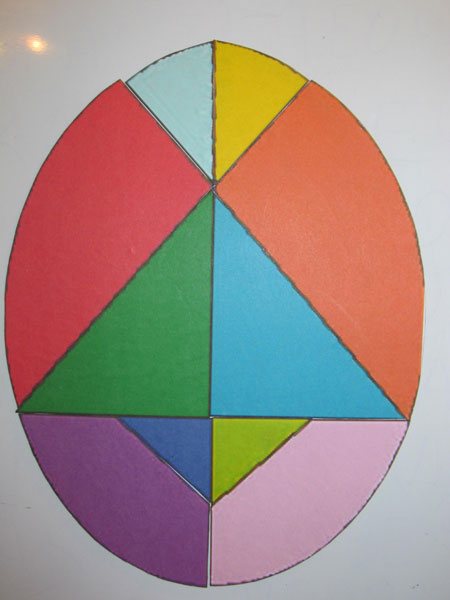
Schemes for it:
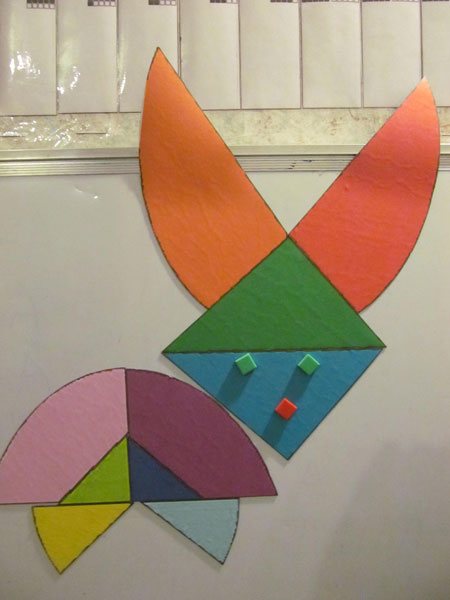
Eyes and noses were added because they are on the diagrams. By the way, other magnets on the reverse side are very magnetic. The Columbus egg has several asymmetrical parts that cannot be replaced with parts from another set, so I will duplicate them. I have already decided that I will not duplicate the entire puzzle, I will only make asymmetrical parts in a mirror image, and according to the rules it will be possible to use only one similar part, they are multi-colored, so I think it will be quite convenient. Well, or, as we did with the duck, mirroring the figures is also an option, and some things can be duplicated well with parts from other sets.
And this is the Vietnamese game:
Almost all of it is asymmetrical, except for two small details, so its double is almost complete:
But I made it in a double version, because there are few parts, but I won’t do things like Stomakhion, where almost all the parts are asymmetrical and there are not 5 of them, on a magnet. Schemes for the Vietnamese game:
Parrot:
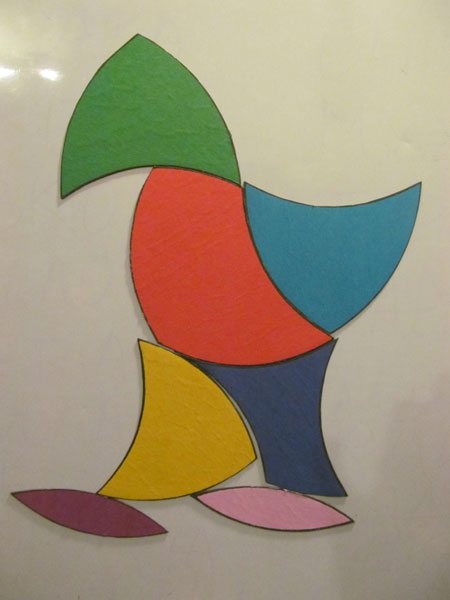
And this is the most unusual puzzle I have ever seen - the letter T:
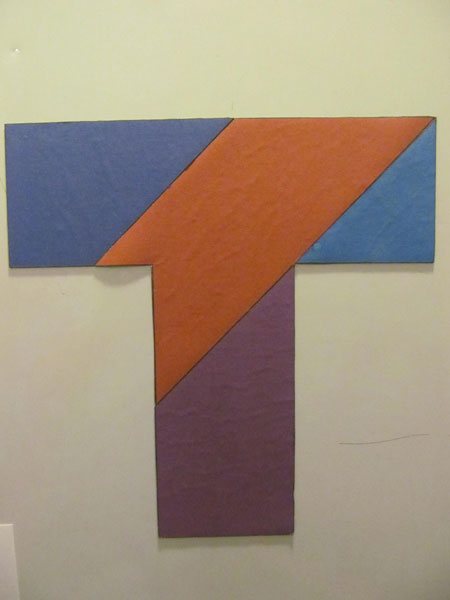
Only 4 parts, but so many possibilities! Another name for it is 100 figures, and there are even tasks by which these figures can be collected. These are not schemes - so it’s not so easy to do it, it’s definitely difficult for Sanya. It’s difficult even for us adults!

This game turned out to be not as simple as it seems at first glance - from its long history to its proportions. It turned out that it had to be cut very cleverly for everything to turn out as it should. But I’ll probably make a separate post about this puzzle someday.
These are the games we now have in addition to our already rather large arsenal)))
A total of 119 sheets.
The puzzle game “Leaf” schematically resembles the shape of a lilac leaf and consists of 9 geometric shapes. The game allows you to build a variety of silhouette figures from geometric elements. Images of real objects are used as samples.
First of all, the game develops logical thinking, imagination, attentiveness and makes you think and reflect.
The “Unusual Leaf” set is intended for a child’s initial acquaintance with the puzzle and is suitable for children from 1.8 years old.
In the set, all drawings and diagrams have drawn borders for overlaying life-size “Leaf” figures. Schemes of one object are presented in three options: color, contour and contour with incompletely drawn borders.
Then we started working with patterns for tangrams - numbers.
There is a piece of paper in front of the child, I read him a poem, then he begins to shade the outline of the number.
Schemes - numbers for tangrams for children
Schemes - numbers for tangrams for children
After the outline of the figure is ready, he begins to lay out the figure from the parts of the tangram.
Schemes - numbers for tangrams for children
Schemes - numbers for tangrams for children
Schemes - numbers for tangrams for children
Then we move on to the next number, read a poem about the number 1, shade the outline of the number and move on to the tangram.
Schemes - numbers for tangrams for children
Schemes - numbers for tangrams for children
Schemes - numbers for tangrams for children
Schemes - numbers for tangrams for children
Schemes - numbers for tangrams for children
Schemes - numbers for tangrams for children
Schemes - numbers for tangrams for children
So sequentially we laid out all the numbers from 0 to 9, and then moved on to the sheets of paper.
This set of leaves also comes in 2 versions: color and outline, each leaf also has coloring and writing.
We chose 3 diagrams from the set: with a house, a rocket and an airplane, and the child laid them out from the details.
Schemes for tangrams for children
Schemes for tangrams for children
Schemes for tangrams for children
If you liked these leaflets - diagrams, then go to the website, where you will find many more useful developmental materials for conducting activities with children at home, in kindergarten and early development schools.
And now a few more photos of how we laid out numbers from parts of the tangram. Good luck to you and your baby!
Schemes - numbers for tangrams for children
Schemes - numbers for tangrams for children
Schemes - numbers for tangrams for children
Schemes - numbers for tangrams for children
Schemes - numbers for tangrams for children
Schemes - numbers for tangrams for children
Schemes - numbers for tangrams for children
Schemes for tangrams for children
Schemes - numbers for tangrams for children
Schemes for tangrams for children
Schemes for tangrams for children
七巧板
Before the advent of computer games and the rapid development of board games, one of the main entertainments for most children and many adults was the tangram puzzle game. The basic element of the tangram is tans, which are obtained by cutting a square into seven geometric shapes. From them you can put together a large number of different shapes (animals, birds, tools, furniture, household items, etc.). The game helps develop logical thinking and geometric intuition.
Tangram
It is likely that the word "tangram" comes from the word "Tan" (which means "Chinese") and the root "gram" (translated from Greek as "letter").
Literally, the word tangram means “seven planks of mastery.” This is a puzzle consisting of seven flat figures that are folded in a certain way to form another, more complex figure (depicting a person, animal, household item, letter or number, etc.).
In China, the name “Tangram” is unknown, but the game is called “CHI-CHAO-TYU”, which translates as “Ingenious Pattern of Seven Parts”, and the term “Tangram” was first used in 1848 by Thomas Hill, the future president of Harvard University, in the booklet Puzzles for Teaching Geometry.
What's included.
34 patterns for overlay, where all the shapes are different colors.
The simplicity of the color version lies in the fact that when superimposing figures, the child uses 2 characteristics - color and shape.
34 diagrams for overlaying, where all the boundaries of the shapes are drawn.
In this version, the baby needs to correlate only one sign - the shape, which is a little more difficult.
34 schemes for overlaying, where not all the boundaries of the figures are drawn.
The number of boundaries drawn is represented by different levels of complexity. This option is even more difficult, since the child needs to think about what shapes to put in the outline.
Each page has a picture that you and your child can color in, making the puzzle activity more fun. The drawings are selected in such a way that they correspond as closely as possible to the depicted diagrams, which helps the child to clearly understand the object he has made from the figures.
34 cards with diagrams for assembly according to the sample.
These cards are presented in 2 options: multi-colored and solid green.
34 picture cards with images of real objects corresponding to the diagrams.
These cards can be used in different ways. Some options:
- When the child has assembled a diagram for overlay, you can ask him to find among these cards an object that is similar to the one he collected from “Leaf”.
- When the child has assembled the diagram according to the sample, you can ask him to find among the pictures the drawing that best suits the assembled diagram.
- Select a picture, and then ask the child to find a diagram similar to this picture and assemble it.
The kit includes 3 types of double-sided “Leaf” for self-production
: multi-colored, all parts are green and colorless.
The last option is so that, after coloring, you and your child can create your own multi-colored or single-color “Leaf”. Self-production options can be used the same as when making tangrams, more about this
The diagrams included in the kit will also fit any “Leaf” puzzle, the size of which is 13cm*13cm.
For the best reproduction of all colors, it is preferable to use photo paper when printing.
Features of the paper version
68 cards with diagrams and pictures, printed on matte photo paper with a density of 170 g/m2. and laminated.
107 A4 overlay pattern cards, printed on premium quality 80gsm paper.
1 “Leaf” head, double-sided, printed on matte photo paper with a density of 100 g/m2 and glued to decorative foam.
Play, develop in a fun and exciting way!
A large set for the “Leaf” puzzle: 34 diagrams for overlay in three versions (different degrees of complexity), diagrams for assembling according to a sample, cards - pictures of real objects for correlation with the diagram and “Leaf” templates for self-production.
A total of 119 sheets.
Electronic version - 119 sheets for printing on A4 format.
Paper version - 68 cards with diagrams and pictures + 107 cards with diagrams for overlay in A4 format + 1 Leaf puzzle
Do you like to play?
- The significance and indispensability of games in our lives has long been proven by many psychologists, scientists and life itself. We have been playing since childhood, learning to communicate while playing and building relationships. Gathering with the whole family or with friends, chatting about different things, treating everyone to something tasty, playing a few exciting games of a board game - all this is what gives our life a special flavor.
Today, the passion for board games is becoming total. After all, modern board games are not only “adventure” games, but also strategic, economic, detective, and logical games.
There are already up to 10 thousand board games of various themes in the world. Of course, it’s impossible to keep up with all the innovations, and some games are too expensive. But you can make the game yourself
Here are some games.
Tangram
Puzzle games for recreating figurative images from geometric shapes are used to improve visual perception, analysis, visual memory, and combinatorics. Sets of shapes are parts of a shape cut in a certain way: square, rectangle, circle or oval. They are interesting to children. The children were fascinated by the result - to compose what they saw on the sample or what they had planned.
The success of children's learning to play depends on the children's sensory development. Children named geometric shapes, their properties, their distinctive features, and moved the shapes freely. Children develop the ability to analyze images, identify geometric shapes, modify shapes by cutting and assemble them from parts. There are various puzzle games for recreating planar images of objects, animals, birds, houses, ships from geometric shapes, such as: “Tangram”, “Pythagoras”, “Sphinx”, “Magic Circle”, “Columbus Egg”, “Leaf” , “Vietnamese Game”, “Pentamino”.
But now we will consider only one of them - “Tangram”.
The appearance of this Chinese puzzle is associated with a beautiful legend. Almost two and a half thousand years ago, the middle-aged Emperor of China gave birth to a long-awaited son and heir. Years passed. The boy grew up healthy and smart beyond his years. One thing bothered the old emperor. The boy took great pleasure in playing with toys all day long. The emperor called to himself three wise men, one of whom was known as a mathematician, another became famous as an artist, and the third was a famous philosopher, and ordered them to come up with a game, by playing with which, his son would comprehend the principles of mathematics, learn to look at the world around him with the gaze of an artist , would become patient, like a true philosopher, and would understand that complex things are often made up of simple things. Three wise men came up with "Shi-Chao-Tyu" - a square cut into seven parts.
They say that tangram was the favorite game of Napoleon, who, having lost his throne, spent long hours in exile playing this game, “exercising his patience and resourcefulness.”
The essence of the game is to create a wide variety of shapes and silhouettes of objects according to a model or design on a plane of seven parts of a square. Commercial kits usually come with task cards.
1 option
: Simplest.
If the child is small, ask him to make a figure by superimposing elements on a sample, divided into component parts. Option 2:
If you have figured out the first one, then you can compose the figures according to the example, that is, the picture is in front of you and you compose the elements by looking at the figures divided into parts.
Option 3:
For older children, you can leave only the contours in the figure.
Option 4:
The actual creative task is to come up with and put together a figure yourself.
Kids can also get involved in the puzzle. You can come up with very simple tasks for them. For example, fold two triangles or two rectangles into squares, or triangles into a large triangle or parallelogram. This method allows you to study basic geometric shapes.
You can make a tangram yourself. It's very simple. You will need a puzzle template. Print the Tangram or draw it yourself based on the sample. You can use multi-colored elements, if the child is small - at the same time remember the colors, and it’s more interesting to work - play with colorful
material.
When solving the puzzle, two rules must be followed: first, you must use all seven tangram shapes, and second, the shapes must not overlap each other. Using the mathematical science of combinatorics, more than 5,000 possible variants of folded figures were obtained.
Assembly examples:
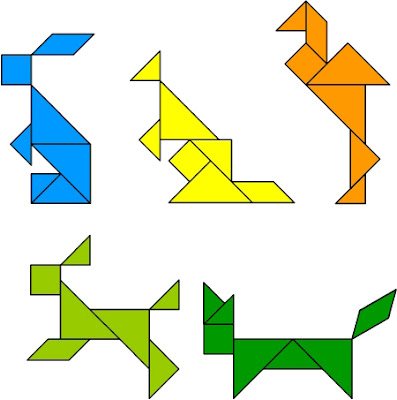
"PYTHAGORAS"
Pythagoras puzzle
very similar to the good old Tangram.
The puzzle
has the shape of a square, cut into 7 parts, combining which you can create a huge number of geometric shapes, silhouettes of animals, people, various objects, etc. All the parts are of different sizes, this is the difficulty, so putting together a figure from them is quite difficult.
In the instructions for the puzzle
15 different tasks are offered.
The Pythagoras puzzle
can be used in mathematics classes, at home or at school, because it perfectly promotes the development of imagination, logic, attention, spatial thinking, mathematical and creative abilities.
You can make a Pythagoras puzzle
and your family will be guaranteed positive emotions and good mood.
MAGIC SQUARE
The geometric puzzle Magic Square belongs to the second level of difficulty and is suitable for children aged 4 years and older. While working with the puzzle, the child will become familiar with simple geometric shapes: triangle, trapezoid, square.

Puzzle “Mongolian game”
A type of geometric puzzle, similar to the “Tangram” or “Pythagorean Square”.
The puzzle is a square cut into 11 parts: 2 squares, one large rectangle, 4 small rectangles, 4 triangles. It is best to make such a puzzle from double-sided cardboard or plastic.
The essence of the game
- assemble figures from these elements using the mosaic principle.
How to play:
Make geometric shapes according to the model. On the Internet you can find ready-made tasks with answers, or you can come up with tasks for your child yourself. In order to draw the figures you will need a checkered sheet. You can take a regular sheet of school paper. The elements that make up the “Mongolian Game” are very simple, and it will not be difficult for you to create compositions from them.
Here, for example, are several figures composed of puzzle elements.
If the child is small, then you can make figures according to the example, that is, figures divided into component parts. For older children, you can leave only the outlines in the figure.
Kids can also get involved in the puzzle. You can come up with very simple tasks for them. For example, fold two triangles or two rectangles into squares, or triangles into a large triangle or parallelogram. This method allows you to study basic geometric shapes.
“SPHINX” puzzle
The “Sphinx” puzzle consists of various geometric shapes: 4 triangles and 3 quadrangles with different aspect ratios. From the elements you can assemble silhouettes of birds, humans, animals, developing observation and geometric imagination. The instructions contain diagrams for constructing more than two dozen figures:
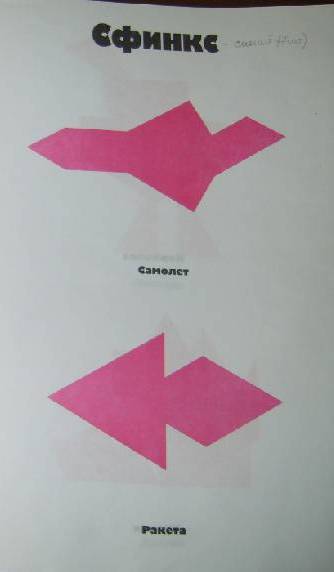
Puzzle games develop spatial imagination, combinatorial abilities, intelligence, ingenuity, and resourcefulness. Easy to understand, but quite difficult to solve, the puzzles walk the fine line between exciting play and intellectual development.
Puzzles from Alexey Shamshin
And another one
Archimedes' puzzle STOMACHION
The proposed puzzle Archimedes game is a unique geometric construction set that was played in ancient times. Its other name is “Stomachion”.
Game elements are obtained by arbitrarily dividing a rectangle into 14 parts. From the resulting parts, various object silhouettes are constructed on a plane, for example, a sitting dog, a running person, various flowers, birds. You can also create multi-figure compositions. It is necessary to introduce the child to the game gradually. Practice recognizing geometric shapes with your child. You can invite the child to count the sides, angles, group the shapes by shape, size, and name them. Then try to construct simple images. To make the Archimedes game easier, it is suggested that you first lay out the figures according to the attached diagrams.
Puzzle "LEAF"
The geometric mosaic puzzle Leaf is designed for children aged 4 years and older. The shape resembles a lilac leaf. This lilac leaf is laid out from other shapes: triangles, squares, trapezoids.
Working with a puzzle develops a child's eye, shape perception, hand-eye coordination, spatial thinking and imagination. Promotes the development of arbitrariness (the ability to play by the rules and follow instructions), cognitive activity, fine motor skills, imagination, the formation of sensory standards of color, size and shape, combinatorial abilities, abstract thinking.
"Magic Circle"
The circle is cut into 10 parts. The rules of the game are the same as in other similar games: use all 10 parts to compose the silhouette, without overlapping one with the other. The cut circle should be colored equally on both sides.

VIETNAMESE GAME The
“Vietnamese Game” includes a circle divided into seven parts and a frame into which the elements are placed. All puzzle pieces are streamlined, some of them are the same size. Invite your child to construct the silhouette of an animal or bird from intricate details. At first, you can use not all elements, then gradually complicate the tasks.
You can design according to diagrams, or you can invent your own plot compositions.
By constructing simple figurative figures, children learn the perception of shape, the ability to isolate a figure from the background, and identify the main features of an object.
The puzzle develops the eye, analytical and synthetic functions, imagination (reproductive and creative), hand-eye coordination, and the ability to work according to rules. The game is intended for children over 4 years old COLUMBUS' EGG
There is a story - perhaps a fictional one. The discoverer of America, Columbus, was invited to the almighty Cardinal Mendoza. At the table, at the request of the guests, he began to tell how exactly the New World was discovered by him (which, however, he considered India). Someone present, a limited but self-confident person, shrugged his shoulders and said: “Is it so simple?”
Columbus looked at him and handed him a chicken egg lying on a dish: “Make it stand on its toe.” Of course, attempts to install the egg were unsuccessful. “This is unthinkable...” said Columbus’s discouraged interlocutor. “It's very simple!” - the navigator answered with a grin and, breaking the sock of an egg on the table, easily made him stand.
The expression “Columbus egg” has become the embodiment of a witty and unexpected way out of a difficulty, synonymous with a simple resolution of difficult issues.
Let's get acquainted with the fascinating puzzle Columbus's Egg, which will perfectly brighten up time on the road, waiting at the clinic and, of course, develop the child's logic and thinking. The principle of the game is simple. Cut the egg figurine along the lines into small parts. The child’s task is to assemble the figurine according to the model. But sometimes you can fantasize and come up with your own options, and see a familiar image in the figure.
Here are the figures with tasks
Pentamino
Famous logic puzzle game. It was this game that inspired Alexey Pajitnov to create the popular computer game Tetris.
Pentamino is a very popular logic game and puzzle at the same time. The elements in the game are flat figures, each of which consists of five identical squares. There are a total of 12 pentomino elements, denoted by Latin letters, the shape of which they resemble
You can make pentominoes from cubes, but then you will need to glue and cover 60 cubes with colored film - a bit difficult. We suggest making elements from thick cardboard.
- We draw each element on hard cardboard, cut it out, check that the element fits into the “U” element. Trim excess if necessary. We drew details from 2.5x2.5 cm squares.
- We trace the finished cardboard element on colored paper folded in half and cut out two colored parts at once. It’s better to make colored parts smaller than cardboard ones, and they stick better, and the corners will be more even.
- We glue colored paper with a glue stick on both sides of the cardboard.
- We find a box for storing parts, where we will also put diagrams and tasks for the game later.
